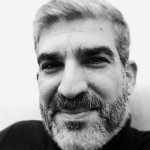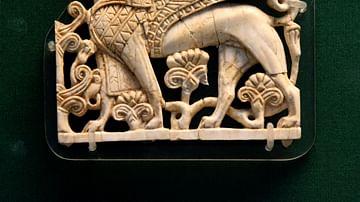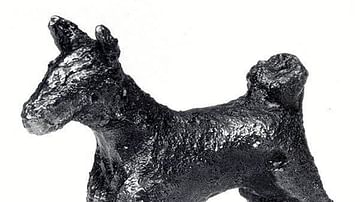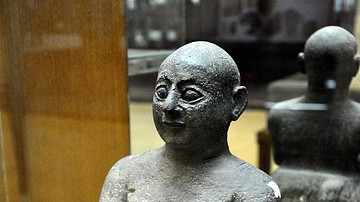For whom have I labored?
For whom have I journeyed?
For whom have I suffered?
I have gained absolutely nothing for myself,
I have only profited the snake, the ground lion!
The Epic of Gilgamesh, Tablet XI
This is how the Epic of Gilgamesh concludes; there is no immortality. Gilgamesh was wrong! The echoes of his Epic has been resonating within the universe over the past 5 millennia and its message will keep reverberating for good and forever, carrying with it the scent of Mesopotamia.
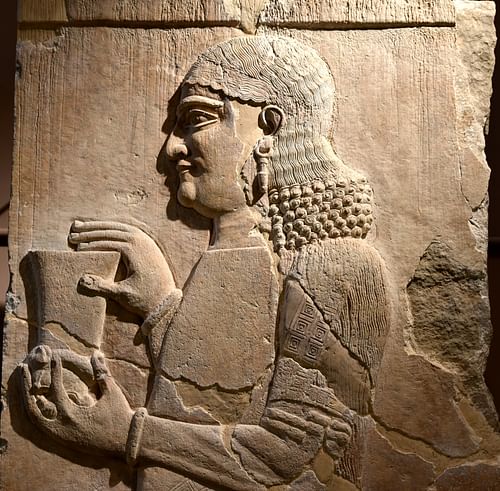
The Beginnings
The British army conquered Baghdad and defeated the Ottomans on March 10, 1917 CE. Miss Gertrude Bell was appointed Oriental Secretary by Major-General Sir Percy Cox, then Higher Commissioner of Iraq. Bell was an English politician, writer, and traveller, and demonstrated an extreme passion for archaeology. After the end of World War I, many archaeological teams from Europe and America started excavating Mesopotamia. Bell was appointed interim honorary director of the Directorate of Archaeology on October 22, 1921 CE. She supervised and directed excavation work throughout Iraq and collaborated with many Western teams. The number of relics unearthed was booming from this legal digging. Many of these artefacts were put in a temporary exhibition which opened on March 11, 1921 CE.
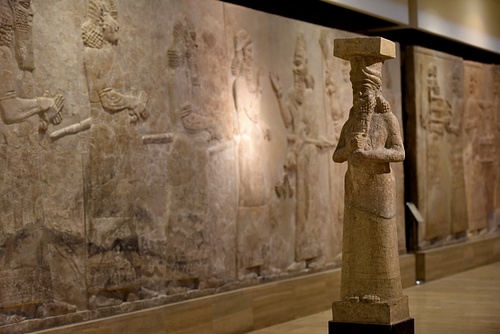
Bell, in order to preserve the Mesopotamian culture as well as its artefacts and relics, started to store such objects in the lower story of the “Qushla Building” in Baghdad in 1922 CE. This room of the government building became known as the “Room of the Babylonian Rocks”, the nucleus of the future “Baghdad Archaeological Museum”. Her own modest artefact collection provided the basis but she also helped to establish the British School of Archaeology in Iraq and, as the number of artefacts was growing, a larger building was a must. Bell negotiated with the Iraqi Government in order to get another building, suitable for housing and displaying the enlarging Mesopotamian collection and, in the end, the Government Printing House was chosen. Although the two-story building had been completed just years before, Bell renovated it extensively to convert it to a museum.
The Baghdad Archaeological Museum was officially opened at 8:00 AM, on June 14, 1926 CE. Bell, as newly appointed director, described the museum as a 'Mini British Museum' where the public would find several artefacts, serially arranged according to their historical period, and each item is described in English and Arabic text. On July 12, 1926 CE, Bell died of an overdose of sleeping pills. Her British successors, Richard Cooke and then Assyriologist Sydney Smith, were both dismissed from office because of smuggling illegally excavated artefacts. From 1931 CE, Mr. Julius Jordan, a German, took office until October 1934 CE. Jordan was one of the key figures in the so-called “Arpachiyah Scandal” in 1933 CE when he ignored the Iraqi Government's instructions and regulations (on how to divide the excavated antiquities between Iraq and Western teams). After that, Mr. Sati Al-Husari was appointed; he was the first Iraqi archaeologist to preside over the Museum's administration, 2 years after the independence of the Kingdom of Iraq from the British mandate.
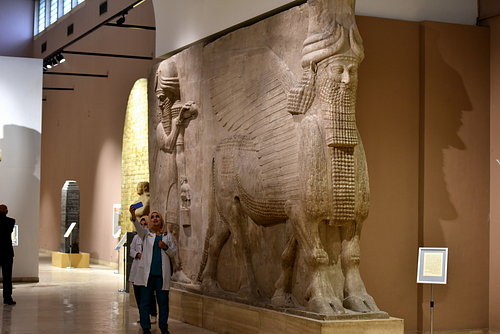
New Building
The relatively stable political and economic situation of the Kingdom of Iraq in the late 1940s and 1950s resulted in more prosperity, also in the field of archaeology. More and more expeditions from the Western countries were working and unearthing more and more relics. The Baghdad Archaeological Museum absorbed all of the artefacts which were stored at the Qushla Building and accommodated the increasing number of acquisitions. However, the building was becoming full and storage boxes would soon overflow; there was no more space. The museum had to be replaced by another larger one in order to accommodate this fruitful growth.
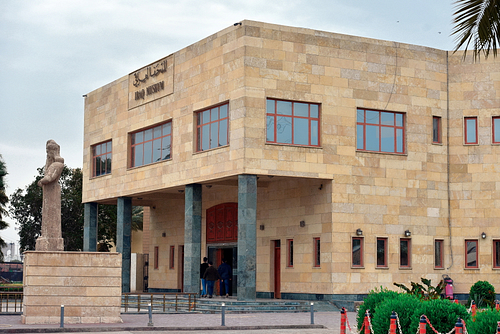
One of the pioneers in proposing and funding a new museum building was the American School of Oriental Research in July 1929 CE. However, the economic recession in the United States dampened this project. Another unsuccessful attempt was made by the Directorate of Antiquities in January 1934 CE. Finally, on May 26, 1938 CE, the Directorate of Antiquities was able to get the necessary funds from the Ministry of Finance and to acquire the land in Al-Salihiyyah District from the Directorate of Railways. The area was originally c. 63,730 square metres; however, it was reduced to the current 45,000 square metres.
German architect Werner March designed the museum complex at the new striking location, near the International Railway Station and Al-Alawi Station in central Baghdad. Travellers and tourists coming from the Baghdad International Airport can also easily access the museum. The construction work started before World War II. However, the progress was halted in 1940 CE because of the war. It was not until December 28, 1955 CE that the construction work was resumed because of technical, administrative, and financial obstacles in the contracts.
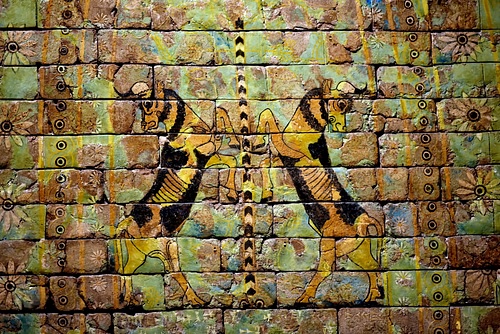
In a ceremony, King Faisal II set up the foundation stone of the new building in Al-Salihiyyah District in Baghdad on March 24, 1957 CE. The current building complex (of the Museum and the General Directorate of Antiquities) was completed in 1963 CE. However, the museum's contents were transferred to the new building later on, and the Museum was officially opened in a ceremony on November 9, 1966 CE. The new National Museum of Iraq was open to the public from 8:00 AM to 5:00 PM, even on Fridays, with 13 galleries, from prehistory to the late Islamic period.
The First Nail in the Coffin
The Iraq-Iran war spanned eight years, from September 1980 CE to August 1988 CE, which had exhausted the country's resources. The Museum, however, was open to the public (the Iraqi laws state that museums should close in war times). Many excavation teams from all around the world were somewhat reluctant to visit Iraq; after all, it is a war zone. A short 2-year period of peace ensued when scholars could breathe some sigh of relief and visit Iraq.
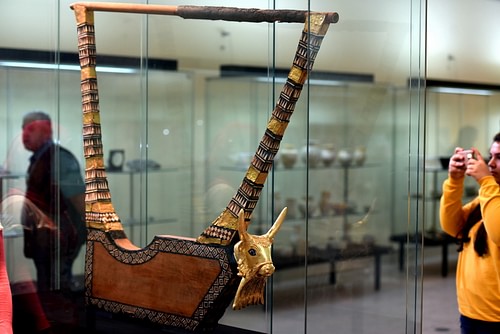
The landmark event in the modern history of the Middle-East was the invasion of Kuwait by Saddam on August 2, 1990 CE, which triggered international economic sanctions and Operation Desert Storm of the First Gulf War on January 17, 1991 CE. Needless to mention the Iraqi people uprising and turmoil in March 1991 CE against the Regime. The field of archaeology and the Iraq Museum received a huge blow with a deep and lasting impact. Many satellite museums in Iraq were closed; although some of their contents were transferred to Baghdad for safekeeping, many of them were burned and looted during the 1991 CE uprisings.
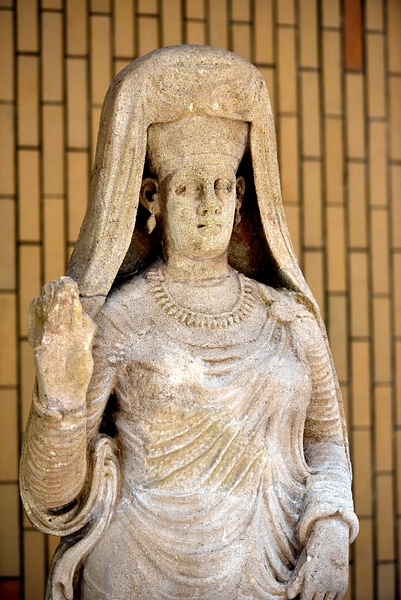
Several archaeological sites all around the Republic of Iraq were easy prey for looters, and the 1990s CE was a flourishing era for artefact smuggling from Iraq. The Iraq Museum was still in a shut-down state, although it was opened for a festival, temporarily, on April 28, 1999 CE, and that would be the birthday of Saddam Hussein. High-ranking officials and several diplomatic missions, as well as the public, attended that ceremony.
The Tsunami
The United States organized and led an international coalition to oust Saddam in 2002 CE. As the drums of war started to beat, and the war was inevitable, a series of events rapidly developed:
January 24, 2003 CE: The Archaeological Institute of America issued an urgent statement calling for the protection of Iraq's archaeological heritage. On the same day, at a meeting with the Pentagon and State Department officials, many concerned groups warned about looting threat.
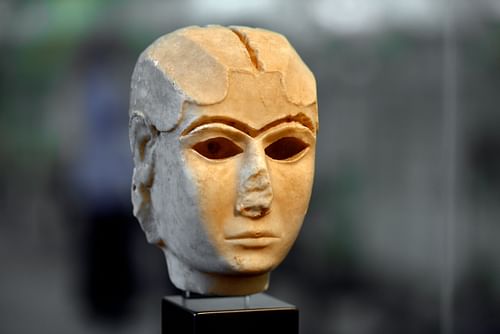
February 27, 2003 CE: The Iraq Museum officially closed. Its day-to-day operations concluded and the staff terminated their routine duties, except for a specialized committee (the process of packing and relocating artefacts was conducted between February 20 to 23, 2003 CE). The Iraq Museum's staff emptied most of the museum's galleries and stored artefacts and documents in secret places and bombs shelters. Large statues, stelae, and friezes were kept in the public galleries, protected by foam and sandbags. On the same day, the Society for American Archaeology wrote to the Secretary of Defense, Donald Rumsfeld, urging for the protection of antiquities in Iraq.
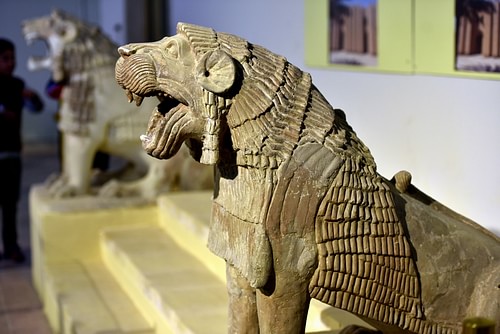
March 6, 2003 CE: The International Council on Monuments and Sites requested all governments to help protect Iraq's cultural property.
March 17, 2003 CE: US President George W. Bush gave Saddam and his sons 48 hours to leave Iraq, or else, he would face war.
March 19, 2003 CE: The International Committee of the Blue Shield issued an urgent statement calling for the prevention and damage of Iraq's cultural heritage.
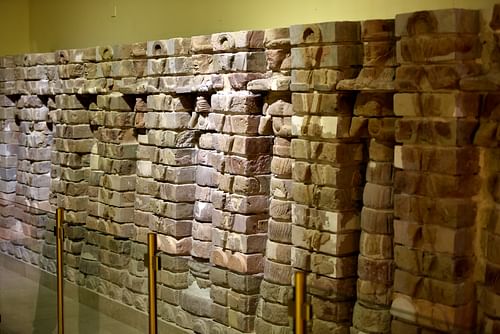
March 20, 2003 CE: The war began with an extensive assault.
March 27, 2003 CE: UNESCO's Director-General, Koïchiro Matsuura, urged the USA to protect Iraq's cultural heritage.
April 5, 2005 CE: American troops entered Baghdad and engaged with Republican Guards, Iraqi Army, and various paramilitary militias.
April 8, 2003 CE: Iraq Museum's staff and employees ran away and abandoned the museum as the military conflict approached. American troops engaged with Iraqi soldiers and snipers within the museum; a US tank fired at the museum's façade.
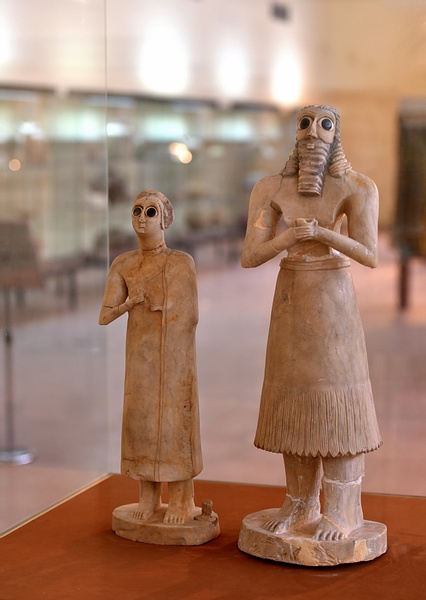
April 9, 2003 CE: Saddam's regime collapsed and the US army occupied Baghdad completely.
April 10 and 11, 2003 CE: Looting and vandalism began.
April 12, 2003 CE: The museum's staff and the public arrived to protect and secure the museum, using their personal weapons. International media arrived and shocking images and videos of the plundered Iraq Museum spread around the World, inciting an international outcry.
April 13, 2003 CE: The Iraq Museum administration asked the US army to intervene and prevent further looting.
April 14, 2003 CE: US Secretary of State, Colin Powell, promised protection to the museum and recovery of the damage.
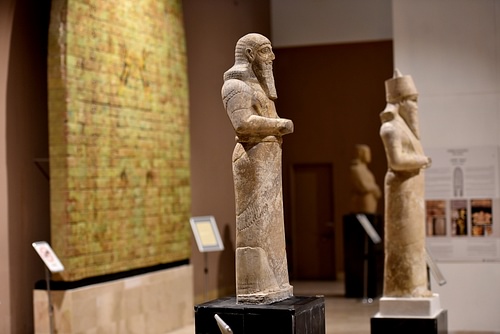
April 15, 2003 CE: The Iraq Museum was still in a state of insecurity.
April 16, 2003 CE: After idly watching the looting for six days with no order to intervene, the American troops finally entered and secured the museum.
April 17, 2003 CE: The museum's employees started cleaning up and registering the contents. On the same day, the UNESCO conducted an international meeting of experts in France about the disaster of the Iraq Museum.
April 21, 2003 CE: A group of American investigators arrived headed by Marine Colonel Matthew Bogdanos to assess the looting.
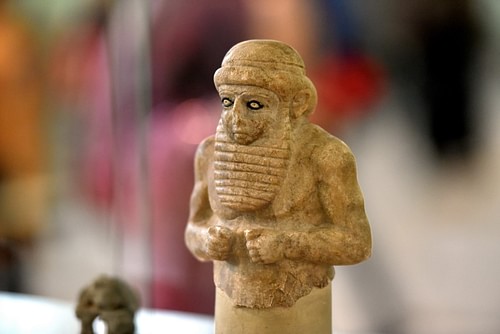
In general, four types of lootings were identified:
- Some of the earliest lootings were haphazard, random, and disorganized; some replicas were looted while adjacent genuine pieces were left undisturbed and intact. In addition, many such looters concentrated on furniture, computers, TV sets, lab instruments, cars, etc. Poor people living around the museum were thought to be the culprit.
- Other plunderers focused on the public galleries and they knew exactly what to take; the Vase of Warka, Mask of Warka, Bassetki Statue, and the Great Golden Lyre of Ur were targeted. The headless statue of the Sumerian king Entemena of Lagash was the heaviest object looted from the museum.
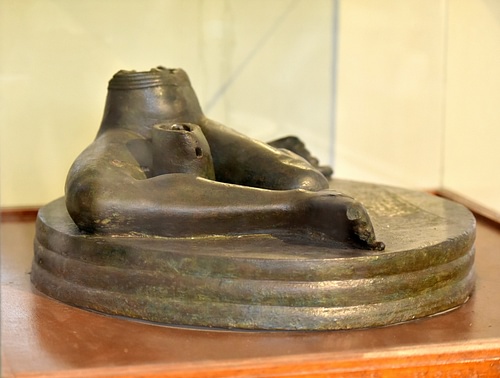 The Bassetki Statue at the Iraq Museum
The Bassetki Statue at the Iraq Museum - Aboveground storage rooms: Their doors showed no signs of damage or forced entry; a multitude of pottery shreds, jars, vessels, etc. were looted. It was probably an inside operation.
- Underground storage rooms: Here, the most valuable yet lightweight and easily transportable relics, such as thousands of cylinder seals, beads, and jewellery, were stored in a very remote and hidden place, inside cabinets and boxes. Evidently, this looting was an inside job, as the looters had keys of the cabinets and they knew what was inside.
The precise number of stolen artefacts is unknown, but a figure of around 15,000 is an acceptable one; there are many exaggerations in the media, e.g., 170,000 and even 600,000 artefacts were said to be looted. Approximately, 6000 objects have been recovered so far.
Rehabilitation
The museum was regaining its health gradually but remained closed to the public. On July 3, 2003 CE, the Iraq Museum was opened for 2 hours only to display the Nimrud Treasure, which was found at the flooded vault of the Central Bank of Iraq on June 1, 2003 CE. Paul Bremer, then administrator of the Coalition Provisional Authority in Iraq, attended the exhibition with politicians and journalists (no public entry). The museum was closed after that and the next day the Nimrud Treasure was transferred back to a safe place. Every now and then, a stolen artefact was returned.
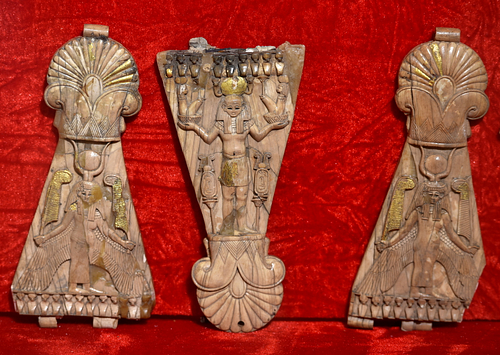
Renovation and refurbishment started in 2004 CE, with a new security system, cameras, laboratories, etc. In December 2008 CE, the museum was opened for journalists and for few hours only; politician Ahmad Chalabi recovered some stolen artefacts. On February 23, 2009 CE, then Prime Minister, Noori Al-Maliki opened the Museum for one day to send a message to the world that the situation in Iraq is stable. For the very first time, on June 9, 2009 CE, some of the masterpieces of the Iraq Museum went online through the Italian project of the Virtual Museum of Iraq. On November 2011 CE, Google Street View technology was used to formulate a virtual free tour of the museum.
Resurrection
In the following years, gradually, each and every gallery was renovated and restored, and the contents were displayed in modern glass containers. The museum was officially reopened to the public on February 28, 2015 CE, by then Prime Minister Haider al-Abbadi. Revived by its visitors, people can now visit the museum from Saturday to Thursday, 9:00 AM to 1:30 PM. The ticket is 3,000 Iraqi Dinars (about $2.50) for Iraqis and 25,000 Iraqi Dinars for foreigners (approximately $20.00). Photography (with no flash) is allowed. There are lockers where you can put your bags. The staff is very friendly, and the environment, overall, is very joyful. There is a photographer, who takes snapshots of the visitors (with their permission); he uploads them to a Facebook page, Iraqi Museum Friends, almost daily. There are 23 galleries, spanning all periods in history and a new "Al-Marjan Gallery" was added recently.
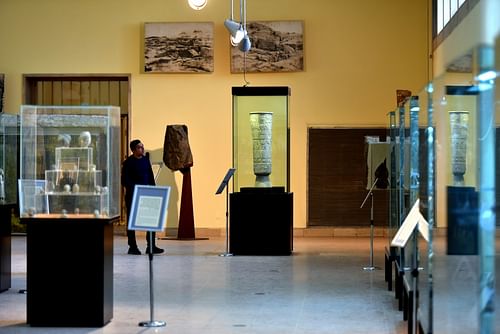
The last time I went to the Iraq Museum, I think was in 1978 or 1979 CE. This is the first time I visited Baghdad (my place of birth, school years, and the medical college period) since 2009 CE and I had only 3 days. I dedicated half a day to visit the Iraq Museum, and that was March 14, 2019 CE. When we arrived, I had a strange mix of overwhelming and conflicting feelings of happiness, sadness, nostalgia, tearfulness, rage, and paralysis. Once I bought the tickets and got through the security check, I was overwhelmed by the hospitality of the staff and very cheerful environment, where hundreds of school children were entertaining themselves. Seeing Mesopotamian artefacts in the Iraq Museum feels very different from when you see them in museums outside Iraq.
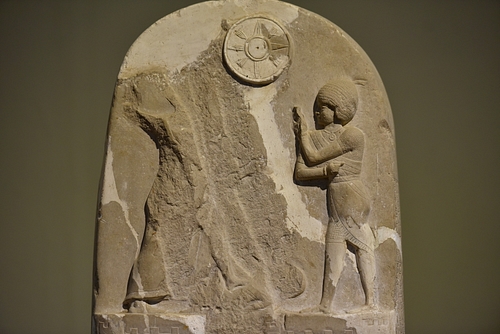
In the few hours I spent there, I took about 10,000 photos. Then I went to visit archaeologist Dr. Jinan Mansour with my friend Nawfal Mohammad, also an archaeologist; they both work there. I took a cup of tea and chatted with them in the adjacent General Directorate of Antiquities. When I left, I took a last look, thinking "will I be able to visit the museum again?" I hope so!
History had made Iraq the legitimate heir of the Mesopotamian legacy and the centre of the history of humanity. Iraq in general, and Baghdad specifically, was a 'melting pot' of diverse people with different religions and cultures creating a single solid body.
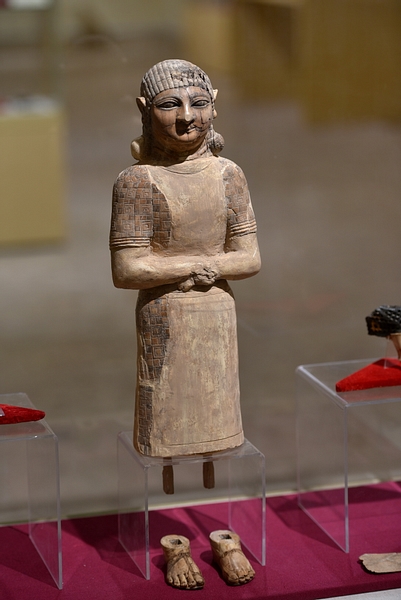
I am very grateful to the Iraq Museum and its staff; without their efforts, the world would have not been able to see its legacy. Special gratitude goes to Nawfal Mohammad and Dr. Jinan Mansour for their extreme hospitality.
